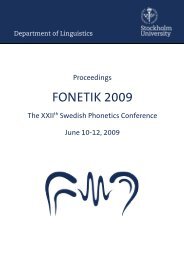The Double Passive in Swedish - Institutionen för lingvistik ...
The Double Passive in Swedish - Institutionen för lingvistik ...
The Double Passive in Swedish - Institutionen för lingvistik ...
You also want an ePaper? Increase the reach of your titles
YUMPU automatically turns print PDFs into web optimized ePapers that Google loves.
2. Background<br />
In a governmental writ<strong>in</strong>g guide (Myndigheternas skrivregler, 2009:24) it is suggested to avoid the<br />
<strong>Double</strong> <strong>Passive</strong> <strong>in</strong> “correct” <strong>Swedish</strong> writ<strong>in</strong>g. Instead, the use of active voice is recommended. And <strong>in</strong><br />
the literature there are “compla<strong>in</strong>ts” regard<strong>in</strong>g the grammaticality of the <strong>Double</strong> <strong>Passive</strong>. E.g.<br />
Wellander (1939:293) considers the double passive not be<strong>in</strong>g grammatically acceptable, and he argues<br />
for the use of its active counterpart. Consider Wellander’s examples <strong>in</strong> (4) 3 :<br />
(4) a) (?)Saken har forsökt-s tysta-s ned.<br />
Issue:the have:AUX try:SUP-PASS quiet:INF-PASS down.<br />
‘As for the issue, it has been tried to be avoided’ (by someone).<br />
b) (?)Ersättn<strong>in</strong>g som vägrat-s (att) utbetala-s.<br />
Payment which refuse:SUP-PASS (to) pay:INF-PASS<br />
‘As for payment, which has been refused to be payed out’ (by someone).<br />
Sundman (1987:467) agrees with Wellander, and argues for the unacceptability of the <strong>Double</strong> <strong>Passive</strong><br />
<strong>in</strong> <strong>Swedish</strong>. Consider Sundmans example <strong>in</strong> (5):<br />
(5) (*)Patienten beslöt-s operera-s.<br />
Patient:the decide:PST-PASS operate:INF-PASS<br />
‘As for the patient, she/he was decided to be operated’ (by the doctor).<br />
In the thesis there is no evaluation of the grammaticality or un-grammaticality of the <strong>Double</strong> <strong>Passive</strong><br />
be<strong>in</strong>g done. <strong>The</strong> <strong>Double</strong> <strong>Passive</strong> is used <strong>in</strong> both spoken and written <strong>Swedish</strong>, despite the<br />
recommendations to avoid it.<br />
Before describ<strong>in</strong>g the constituents of a <strong>Double</strong> <strong>Passive</strong> construction, short presentations of <strong>Swedish</strong>,<br />
passive voice and Lexical functional grammar are given below.<br />
2.1 <strong>Swedish</strong> <strong>in</strong> brief<br />
<strong>Swedish</strong> basically has the word order; subject - f<strong>in</strong>ite verb - object (SVO). It is partly an analytic<br />
language – lexemes, word order and prepositions are often used to <strong>in</strong>dicate semantic and syntactic<br />
relations, which <strong>in</strong> other languages might be <strong>in</strong>dicated morphologically (SAG 1, 1999:23). In (6), an<br />
example of an auxiliary verb (a lexeme) <strong>in</strong>dicat<strong>in</strong>g a semantic and syntactic relation to a head verb <strong>in</strong><br />
<strong>Swedish</strong> is shown:<br />
3 <strong>The</strong> translation ”As for the (…)” is <strong>in</strong>dicat<strong>in</strong>g the topicality of a referential subject <strong>in</strong> the <strong>Double</strong> <strong>Passive</strong><br />
(cf. Ørsnes (2006).<br />
10

















